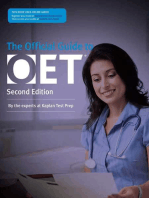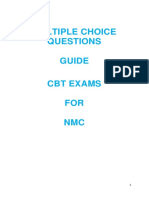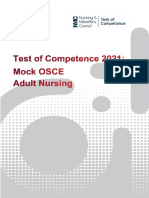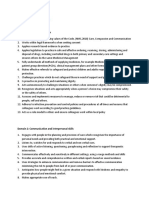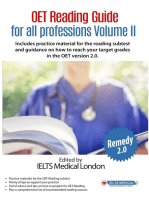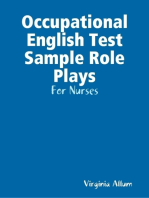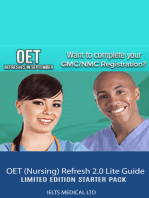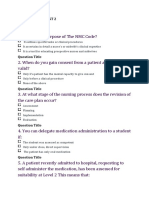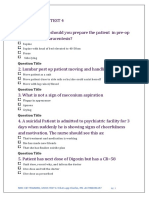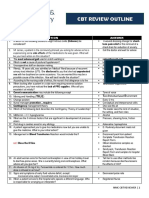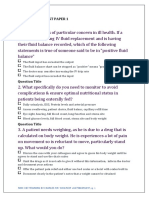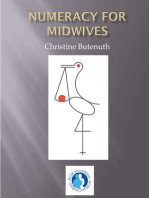Professional Documents
Culture Documents
NMC CBT Mock Test 3.: Question Title
NMC CBT Mock Test 3.: Question Title
Uploaded by
Charles Osiako50%(2)50% found this document useful (2 votes)
377 views14 pagesThis document contains a mock test for the NMC CBT exam with 24 multiple choice questions covering various nursing topics. Some of the questions address patient assessments, infection control procedures, abuse reporting requirements, and communication skills. The test questions cover concepts like AVPU, PPH classifications, isolation precautions, needlestick protocols, and demonstrating supportive communication to patients.
Original Description:
Original Title
NMC CBT MOCK TEST 3
Copyright
© © All Rights Reserved
Available Formats
PDF, TXT or read online from Scribd
Share this document
Did you find this document useful?
Is this content inappropriate?
Report this DocumentThis document contains a mock test for the NMC CBT exam with 24 multiple choice questions covering various nursing topics. Some of the questions address patient assessments, infection control procedures, abuse reporting requirements, and communication skills. The test questions cover concepts like AVPU, PPH classifications, isolation precautions, needlestick protocols, and demonstrating supportive communication to patients.
Copyright:
© All Rights Reserved
Available Formats
Download as PDF, TXT or read online from Scribd
Download as pdf or txt
50%(2)50% found this document useful (2 votes)
377 views14 pagesNMC CBT Mock Test 3.: Question Title
NMC CBT Mock Test 3.: Question Title
Uploaded by
Charles OsiakoThis document contains a mock test for the NMC CBT exam with 24 multiple choice questions covering various nursing topics. Some of the questions address patient assessments, infection control procedures, abuse reporting requirements, and communication skills. The test questions cover concepts like AVPU, PPH classifications, isolation precautions, needlestick protocols, and demonstrating supportive communication to patients.
Copyright:
© All Rights Reserved
Available Formats
Download as PDF, TXT or read online from Scribd
Download as pdf or txt
You are on page 1of 14
NMC CBT MOCK TEST 3.
1. A 17-year-old patient who was involved in an orthopaedic accident is
observed not eating the meals that she previously ordered and refuses to
take a bath even if she is already in recovery stage. As a nurse what do you
think is the best explanation for her reaction to the accident that happened
to her?
Supression
Undoing
Regression
Repression
Question Title
2. What does AVPU mean?
alert verbalization pain unconscious
awake voice pain unconscious
alert voice pain unresponsive
awake verbalization pain unconscious
Question Title
3. Where will you put infectious linen?
red plastic bag designed to disintegrate when exposed to heat
red linen bag designed to hold its integrity even when exposed to heat
yellow plastic bag for disposal
Question Title
4. Who is responsible in disposing sharps?
Registered nurse
Nurse assistant
Whoever used the sharps
Whoever collects the garbage
Question Title
MOCK 3 BY CHARLES, RN-Please whats app 0704360343 or +447984691497 pg. 1
5. NMC requires in the UK how many units of continuing education units a
nurse should have in 3 years?
35 Units
45 Units
55 Units
65 Units
Question Title
6. What do you expect to assess in a grade 3 pressure ulcer?
blistered wound on the skin
open wound showing tissue
open wound exposing muscles
open wound exposing bones
Question Title
7. What could be the reason why you instruct your patient to retain on its
original container and discard nitroglycerine meds after 8 weeks?
removing from its darkened container exposes the medicine to the light
and its potency will decrease after 8 weeks
it will have a greater concentration after 8weeks
Question Title
8. An 83-year old lady just lost her husband. Her brother visited the lady in
her house. He observed that the lady is acting okay but it is obvious that she
is depressed. 3weeks after the husband's death, the lady called her brother
crying and was saying that her husband just died. She even said, "I cant
even remember him saying he was sick." When the brother visited the lady,
she was observed to be well physically but was irritable and claims to have
frequent urination at night and she verbalizes that she can see lots of rats in
their kitchen. Based on the manifestations, as a nurse, what will you
consider as a diagnosis to this patient?
urinary tract infection leading to delirium
delayed grieving with dementia
MOCK 3 BY CHARLES, RN-Please whats app 0704360343 or +447984691497 pg. 2
Question Title
9. As you visit your patient during rounds, you notice a thin child who is
shy and not mingling with the group who seemed to be visitors of the
patient. You offered him food but his mother told you not to mind him as he
is not eating much while all of them are eating during that time. As a nurse,
what will you do?
inform social service desk on suspected case of child neglect
ignore incident since the child is under the responsibility of the mother
raise the situation to your head nurse and discuss with her what
intervention might be done to help the child
Question Title
10. You are to take charge of the next shift of nurses. Few minutes before
your shift, the in charge of the current shift informed you that two of your
nurses will be absent. Since there is a shortage of staff in your shift, what
will you do? A.encourage all the staff who are present to do their best to
attend to the needs of the patients B.ask from your manager if there are
qualified staff from the previous shift that can cover the lacking number for
your shift while you try to replace new nurses to cover C.refuse to take
charge of the next shift
encourage all the staff who are present to do their best to attend to the
needs of the patients
ask from your manager if there are qualified staff from the previous
shift that can cover the lacking number for your shift while you try to
replace new nurses to cover
refuse to take charge of the next shift
Question Title
11. Who will you inform first if there is a shortage in supplies in your shift?
Nursing assistant
Purchasing personne
Immediate nurse manager
Supplier
MOCK 3 BY CHARLES, RN-Please whats app 0704360343 or +447984691497 pg. 3
Question Title
12. What do you mean by MRSA?
methicillin-resistant staphyloccocus aureu
multiple resistant staphylococcus antibiotic
Question Title
13. A young mother who delivered 48hrs ago comes back to the emergency
department with post partum haemorrhage. What type of PPH is it?
primary post partum haemorrhage
secondary post partum haemorrhage
tertiary post partum haemorrhage.
Question Title
14. As a registered nurse in a unit what would consider as a priority to a
patient immediately post operatively?
pain relief
blood loss
airway patency
Question Title
15. Which is the most dangerous site for intramuscular injection?
ventrogluteal
deltoid
rectus femoris
dorsogluteal
Question Title
16. A solution contains 12.5 g of glucose in 0.25 l; what is the percentage
concentration (%) of this solution?
5%
10%
25%
Question Title
MOCK 3 BY CHARLES, RN-Please whats app 0704360343 or +447984691497 pg. 4
17. A litre bag of 5% Glucose is prescribed over 4 hours. If a standard giving
set is used, at what rate should the drip be set?
83
60
24
Question Title
18. You believe that an adult you know and support has been a victim of
physical abuse that might be considered a criminal offence. What should
you do to support the police in an investigation?
Question the adult thoroughly to get as much information as possible
Take photographs of any signs of abuse or other potential evidence
before cleaning up the victim or the crime scene
Explain to the victim that you cannot speak to them unless a police
officer is present
Make an accurate record of what the person has said to you
Question Title
19. If you suspect abuse is happening to someone, and it is not serious
enough to involve the police straight away, who should you inform?
A manager with safeguarding responsibility (if within an organisation)
or Adult Social Care directly (if you are a member of the public)
No one – it is up to the adult at risk to raise the alert
The adult's next of kin
Everyone with a caring responsibility for the adult
Question Title
20. If you were told by a nurse at handover to take standard precautions
what would you expect to be doing?
Taking precautions when handling blood and high-risk body fluids so
that you dont pass on any infection to the patient.
Wearing gloves, aprons and mask when caring for someone in
protective isolation to protect yourself from infection.
Asking relatives to wash their hands when visiting patients in the
clinical setting.
MOCK 3 BY CHARLES, RN-Please whats app 0704360343 or +447984691497 pg. 5
Using appropriate hand hygiene, wearing gloves and aprons when
necessary, disposing of used sharp instruments safely and providing care in
a suitably clean environment to protect yourself and the patients.
Question Title
21. What would make you suspect that a patient in your care had a urinary
tract infection?
The doctor has requested a midstream urine specimen.
The patient has a urinary catheter in situ, and the patients wife states
that he seems more forgetful than usual.
The patient has spiked a temperature, has a raised white cell count
(WCC), has new-onset confusion and the urine in his catheter bag is cloudy.
The patient has complained of frequency of faecal elimination and hasnt
been drinking enough.
Question Title
22. You are caring for a patient in isolation with suspected Clostridium
difficile. What are the essential key actions to prevent the spread of
infection?
Regular hand hygiene and the promotion of the infection prevention
link nurse role.
Encourage the doctors to wear gloves and aprons, to be bare below the
elbow and to wash hands with alcohol handrub. Ask for cleaning to be
increased with soap-based products.
Ask the infection prevention team to review the patients medication
chart and provide regular teaching sessions on the 5 moments of hand
hygiene. Provide the patient and family with adequate information.
Review antimicrobials daily, wash hands with soap and water before
and after each contact with the patient, ask for enhanced cleaning with
chlorine-based products and use gloves and aprons when disposing of body
fluids.
Question Title
23. What steps would you take if you had sustained a needlestick injury?
Ask for advice from the emergency department, report to occupational
health and fill in an incident form.
Gently make the wound bleed, place under running water and wash
thoroughly with soap and water. Complete an incident form and inform
MOCK 3 BY CHARLES, RN-Please whats app 0704360343 or +447984691497 pg. 6
your manager. Co-operate with any action to test yourself or the patient for
infection with a bloodborne virus but do not obtain blood or consent for
testing from the patient yourself; this should be done by someone not
involved in the incident.
Take blood from patient and self for Hep B screening and take samples
and form to Bacteriology. Call your union representative for support. Make
an appointment with your GP for a sickness certificate to take time off until
the wound site has healed so you dont contaminate any other patients.
Wash the wound with soap and water. Cover any wound with a
waterproof dressing to prevent entry of any other foreign material
Question Title
24. What factors are essential in demonstrating supportive communication
to patients?
Listening, clarifying the concerns and feelings of the patient using open
questions.
Listening, clarifying the physical needs of the patient using closed
questions.
Listening, clarifying the physical needs of the patient using open
questions.
Listening, reflecting back the patients concerns and providing a
solution.
Question Title
25. Dehydration is of particular concern in ill health. If a patient is receiving
intravenous (IV) fluid replacement and is having their fluid balance
recorded, which of the following statements is true of someone said to be in
a positive fluid balance?
The fluid output has exceeded the input.
The doctor may consider increasing the IV drip rate.
The fluid balance chart can be stopped as positive in this instance
means good.
The fluid input has exceeded the output.
Question Title
26. What specifically do you need to monitor to avoid complications and
ensure optimal nutritional status in patients being enterally fed?
MOCK 3 BY CHARLES, RN-Please whats app 0704360343 or +447984691497 pg. 7
Blood glucose levels, full blood count, stoma site and bodyweight.
Eye sight, hearing, full blood count, lung function and stoma site.
Assess swallowing, patient choice, fluid balance, capillary refill time.
Daily urinalysis, ECG, protein levels and arterial pressure.
Question Title
27. What is the best way to prevent a patient who is receiving an enteral
feed from aspirating?
Lie them flat.
Sit them at least at a 45° angle.
Tell them to lie on their side.
Check their oxygen saturations.
Question Title
28. Which check do you need to carry out before setting up an enteral feed
via a nasogastric tube?
That when flushed with red juice, the red juice can be seen when the
tube is aspirated.
That air cannot be heard rushing into the lungs by doing the whoosh
test.
That the pH of gastric aspirate is <5.5, and the measurement on the NG
tube is the same length as the time insertion.
That pH of gastric aspirate is >6.0, and the measurement on the NG tube
is the same length as the time insertion.
Question Title
29. Why should healthcare professionals take extra care when washing and
drying an elderly patients skin?
As the older generation deserve more respect and tender loving care
(TLC).
As the skin of an elder person has reduced blood supply, is thinner, less
elastic and has less natural oil. This means the skin is less resistant to
shearing forces and wound healing can be delayed.
All elderly people lose dexterity and struggle to wash effectively so they
need support with personal hygiene.
MOCK 3 BY CHARLES, RN-Please whats app 0704360343 or +447984691497 pg. 8
As elderly people cannot reach all areas of their body, it is essential to
ensure all body areas are washed well so that the colonization of Gram-
positive and negative micro-organisms on the skin is avoided.
Question Title
30. What should be included in your initial assessment of your patients
respiratory status?
Review the patients notes and charts, to obtain the patients history.
Review the results of routine investigations.
Observe the patients breathing for ease and comfort, rate and pattern.
Perform a systematic examination and ask the relatives for the patients
history.
Question Title
31. When using nasal cannulae, the maximum oxygen flow rate that should
be used is 6 litres/min. Why?
Nasal cannulae are only capable of delivering an inspired oxygen
concentration between 24% and 40%.
For any given flow rate, the inspired oxygen concentration will vary
between breaths, as it depends upon the rate and depth of the patients
breath and the inspiratory flow rate.
Higher rates can cause nasal mucosal drying and may lead to epistaxis.
If oxygen is administered at greater than 40% it should be humidified.
You cannot humidify oxygen via nasal cannulae
Question Title
32. Why is it essential to humidify oxygen used during respiratory
therapy?
Oxygen is a very hot gas so if humidification isnt used, the oxygen will
burn the respiratory tract and cause considerable pain for the patient when
they breathe.
Oxygen is a dry gas which can cause evaporation of water from the
respiratory tract and lead to thickened mucus in the airways, reduction of
the movement of cilia and increased susceptibility to respiratory infection.
Humidification cleans the oxygen as it is administered to ensure it is
free from any aerobic pathogens before it is inhaled by the patient.
Question Title
MOCK 3 BY CHARLES, RN-Please whats app 0704360343 or +447984691497 pg. 9
33. Which of the following would indicate an infection?
Hot, sweaty, a temperature of 36.5°C, and bradycardic.
Temperature of 38.5°C, shivering, tachycardia and hypertensive.
Raised WBC, elevated blood glucose and temperature of 36.0°C.
Hypotensive, cold and clammy, and bradycardic.
Question Title
34. A nurse is having trouble with doing care plans. Her team members are
already noticing this problem and are worried of the consequences this
may bring to the quality of nursing care delivered. The problem is already
brought to the attention of the nurse. The nurse should:
Accept her weakness and take this challenge as an opportunity to
improve her skills by requesting lectures from her manager
Ignore the criticism as this is a case of a team issue
Continue delivering care as this will not affect the quality of care you are
rendering your patient
Question Title
35. You are in a registered nurse in a community giving health education to
a patient and you notice that the student nurse is using his cell phone to
text, what should you do?
Tell the student to leave and emphasize what a disappointment she is
Report the student to his Instructor after duty
Politely signal the student and encourage him by actively including him
in the discussion
Question Title
36. Which one of the following types of wound is NOT suitable for negative
pressure wound therapy?
Partial thickness burns
Contaminated wounds
Diabetic and neuropathic ulcers
Traumatic wounds
Question Title
MOCK 3 BY CHARLES, RN-Please whats app 0704360343 or +447984691497 pg. 10
37. How long does the ‘inflammatory phase’ of wound healing typically
last?
24 hours
Just minutes
1-5 days
3-24 days
Question Title
38. Which of the following methods of wound closure is most suitable for a
good cosmetic result following surgery?
Skin clips
Tissue adhesive
Adhesive skin closure strips
Interrupted suture
Question Title
39. You notice an area of redness on the buttock of an elderly patient and
suspect they may be at risk of developing a pressure ulcer. Which of the
following would be the most appropriate to apply?
Negative pressure dressing
Rapid capillary dressing
Alginate dressing
Skin barrier product
Question Title
40. What are the four stages of wound healing in the order they take place?
Proliferative phase, inflammation phase, remodelling phase, maturation
phase.
Haemostasis, inflammation phase, proliferation phase, maturation
phase
Inflammatory phase, dynamic stage, neutrophil phase, maturation
phase.
Haemostasis, proliferation phase, inflammation phase, remodelling
phasesupport
Question Title
MOCK 3 BY CHARLES, RN-Please whats app 0704360343 or +447984691497 pg. 11
41. How soon after surgery is the patient expected to pass urine?
1-2 hours
2-4 hours
4-6 hours
6-8 hours
Question Title
42. What functions should a dressing fulfil for effective wound healing?
High humidity, insulation, gaseous exchange, absorbent.
Anaerobic, impermeable, conformable, low humidity
Insulation, low humidity, sterile, high adherence.
Absorbent, low adherence, anaerobic, high humidity
Question Title
43. When would it be beneficial to use a wound care plan?
On all chronic wounds
On all infected wounds.
On all complex wounds.
On every wound
Question Title
44. How would you care for a patient with a necrotic wound?
Systemic antibiotic therapy and apply a dry dressing
Debride and apply a hydrogel dressing.
Debride and apply an antimicrobial dressing.
Apply a negative pressure dressing.
Question Title
45. A new, postsurgical wound is assessed by the nurse and is found to be
hot, tender and swollen. How could this wound be best described?
In the inflammation phase of healing.
In the haemostasis phase of healing.
In the reconstructive phase of wound healing.
As an infected wound
Question Title
MOCK 3 BY CHARLES, RN-Please whats app 0704360343 or +447984691497 pg. 12
46. When a patient is being monitored in the PACU, how frequently should
blood pressure, pulse and respiratory rate be recorded?
Every 5 minutes
Every 15 minutes
Once an hour
Continuously
Question Title
47. Safe moving and handling of an anaesthetized patient is imperative to
reduce harm to both the patient and staff. What is the minimum number of
staff required to provide safe manual handling of a patient in theatre?
3 (1 either side, 1 at head).
5 (2 each side, 1 at head).
4 (1 each side, 1 at head, 1 at feet).
6 (2 each side, 1 at head, 1 at feet).
Question Title
48. Why are anti-embolic stockings an effective means of reducing the
potential of developing a deep vein thrombosis?
They promote arterial blood flow.
They promote venous blood flow.
They reduce the risk of postoperative swelling.
They promote lymphatic fluid flow, and drainage
Question Title
49. You are looking after a postoperative patient and when carrying out
their observations, you discover that they are tachycardic and anxious, with
an increased respiratory rate. What could be happening? What would you
do?
The patient is showing symptoms of hypovolaemic shock. Investigate
source of fluid loss, administer fluid replacement and get medical support.
The patient is demonstrating symptoms of atelectasis. Administer a
nebulizer, refer to physiotherapist for assessment.
MOCK 3 BY CHARLES, RN-Please whats app 0704360343 or +447984691497 pg. 13
The patient is demonstrating symptoms of uncontrolled pain.
Administer prescribed analgesia, seek assistance from medical team.
The patient is demonstrating symptoms of hyperventilation. Offer
reassurance, administer oxygen
Question Title
50. Who should mark the skin with an indelible pen ahead of surgery?
The nurse should mark the skin in consultation with the patient
A senior nurse should be asked to mark the patient's skin
The surgeon should mark the skin
It is best not to mark the patient's skin for fear of distressing the patient.
ANSWERS
1C 2C 3A 4C 5A 6B 7A 8A 9C 10B
11C 12A 13B 14C 15D 16A 17A 18D 19A 20D
21C 22ALL 23B 24A 25D 26A 27B 28C 29B 30C
31C 32B 33B 34A 35C 36B 37C 38A 39D 40B
41D 42A 43D 44B 45A 46A 47C 48B 49A 50C
MOCK 3 BY CHARLES, RN-Please whats app 0704360343 or +447984691497 pg. 14
You might also like
- CBT Mock TestDocument3 pagesCBT Mock TestLip Stick76% (21)
- Final Guide To Cbt-1Document199 pagesFinal Guide To Cbt-1Anderson Alfred93% (30)
- CBT Sample MCQs - Source Royal Marsden ANSWERSDocument16 pagesCBT Sample MCQs - Source Royal Marsden ANSWERSarchana100% (9)
- CBT 2021 ReviewerDocument63 pagesCBT 2021 ReviewerJasmine100% (9)
- AEMT Medications: Drug Card InformationDocument2 pagesAEMT Medications: Drug Card InformationAlex Lupi50% (2)
- NMC CBT NumeracyDocument19 pagesNMC CBT NumeracyTitilope50% (2)
- New CBT 2021Document64 pagesNew CBT 2021Shiela Lyn Tachado100% (13)
- CBT Midwifery Full Mock Test 3 Questions Answers Numerical OrderDocument31 pagesCBT Midwifery Full Mock Test 3 Questions Answers Numerical OrderMimi Boamah100% (3)
- CBT AND OSCE COMPILED REVIEWERS - JayDocument4 pagesCBT AND OSCE COMPILED REVIEWERS - JayLouie Atnhony Tan100% (3)
- NMC OSCE Professional Values Summary (Version 1)Document4 pagesNMC OSCE Professional Values Summary (Version 1)S. Capanateraiso100% (3)
- CBT Mock Test Answered - NewDocument10 pagesCBT Mock Test Answered - NewLip Stick100% (20)
- 2020 AHA Guidelines For CPR & ECCDocument42 pages2020 AHA Guidelines For CPR & ECCArun100% (1)
- NMC CBT Questions and AnswersDocument2 pagesNMC CBT Questions and AnswersKavalam George100% (1)
- Review 2018 PDFDocument262 pagesReview 2018 PDF121456990% (10)
- New NMC CBTDocument43 pagesNew NMC CBTmary grace carpio100% (6)
- Mock Osce Rn1 Toc 2021 v1.1Document42 pagesMock Osce Rn1 Toc 2021 v1.1Ameng GosimNo ratings yet
- CBT - Pearsonvue Practice Test 1Document7 pagesCBT - Pearsonvue Practice Test 1AC100% (4)
- CBT Blissful MaterialDocument223 pagesCBT Blissful MaterialDanial Hassan78% (9)
- CBT Study GuideDocument10 pagesCBT Study Guideplethoraldork100% (5)
- CBT Practice QuizDocument37 pagesCBT Practice QuizAnderson Alfred71% (14)
- NMC CBT Blueprint SummaryDocument4 pagesNMC CBT Blueprint SummaryXy-Za Roy Marie Albaña100% (3)
- NMC CBT Tips and HacksDocument4 pagesNMC CBT Tips and HacksMike Miraran89% (9)
- CBT Training ManualDocument15 pagesCBT Training Manualchandrasekharan madhavan100% (1)
- CBT Questions From RM 9th EditionDocument13 pagesCBT Questions From RM 9th EditionXy-Za Roy Marie Albaña100% (6)
- CBT Practice QuizDocument171 pagesCBT Practice QuizCommynile95% (21)
- CBT Exam QuestionDocument68 pagesCBT Exam Questiondianne ignacio100% (1)
- Test of Competence - Part One - Nursing Test BlueprintDocument133 pagesTest of Competence - Part One - Nursing Test BlueprintApril Palantog100% (7)
- UK Requirements Checklist and Study MaterialsDocument2 pagesUK Requirements Checklist and Study MaterialsKrizle Adaza100% (1)
- CBTDocument181 pagesCBTAnna May Bacal100% (1)
- Occupational English Test Sample Role Plays - For NursesFrom EverandOccupational English Test Sample Role Plays - For NursesRating: 5 out of 5 stars5/5 (1)
- Pediatric Respiratory Cases: DR Hodan S. Ahmed, Department of Pediatrics and Child Health, Amoud Medical School, AUDocument24 pagesPediatric Respiratory Cases: DR Hodan S. Ahmed, Department of Pediatrics and Child Health, Amoud Medical School, AUmukhtar abddiNo ratings yet
- Physioex Ex 7 AnswersDocument5 pagesPhysioex Ex 7 AnswersTin-tinNo ratings yet
- NMC CBT Mock Test 6Document14 pagesNMC CBT Mock Test 6Charles Osiako100% (1)
- NMC CBT Mock Test 2Document13 pagesNMC CBT Mock Test 2Charles Osiako100% (3)
- NMC CBT Mock Test 4Document13 pagesNMC CBT Mock Test 4Charles Osiako50% (2)
- CBTDocument20 pagesCBTasharoopsing30% (1)
- 1Document60 pages1aman100% (5)
- NMC CBT Sample Q&a Part 3 AcDocument14 pagesNMC CBT Sample Q&a Part 3 AcJoane FranciscoNo ratings yet
- CBT NotesDocument8 pagesCBT NotesNom Nom75% (4)
- NMC CBT Mock Test 1Document15 pagesNMC CBT Mock Test 1Charles Osiako33% (3)
- NEW CBT 2021 W RationaleDocument82 pagesNEW CBT 2021 W RationaleShini JosephNo ratings yet
- We-Sol CBT Sample MCQsDocument16 pagesWe-Sol CBT Sample MCQsLip Stick100% (5)
- CBT Reviewer TipsDocument12 pagesCBT Reviewer TipsJohn Bryan TuganoNo ratings yet
- Revised OSCE Top Tips Nursing Version R1.10 Dec2020Document23 pagesRevised OSCE Top Tips Nursing Version R1.10 Dec2020Jessilen Consorte Nidea Dexisne100% (1)
- CBT Study Guide Test of Competence Part 1 - Nursing TestDocument11 pagesCBT Study Guide Test of Competence Part 1 - Nursing TestElvin AraoNo ratings yet
- CBT Reviewer TipsDocument11 pagesCBT Reviewer TipsMigz Brosas100% (1)
- Set B CBT 2Document23 pagesSet B CBT 2Anderson Alfred100% (3)
- Test of Competence Part 1 Candidate HandbookDocument14 pagesTest of Competence Part 1 Candidate HandbookVictor Conde100% (2)
- CBT Study Guide Test of Competence Part 1Document12 pagesCBT Study Guide Test of Competence Part 1Chendur100% (1)
- Various CBT Tips From PassersDocument6 pagesVarious CBT Tips From PassersJmae Tag'xNo ratings yet
- NMC CBT - Sample Exam Practice 2 AnswersDocument7 pagesNMC CBT - Sample Exam Practice 2 AnswersSupremo Manuel M Deluao75% (4)
- Test of Competence 2021 Osce Information Booklet For Nurses (1) M. TawaklDocument46 pagesTest of Competence 2021 Osce Information Booklet For Nurses (1) M. Tawaklloave.mando.7100% (1)
- CBT Questions 1Document23 pagesCBT Questions 1boby100% (3)
- 1,000 Questions Questionnaire (Resized Printable)Document91 pages1,000 Questions Questionnaire (Resized Printable)Jerushua Acuna100% (2)
- New Test of Competence Webinar Slides 19 NovemberDocument32 pagesNew Test of Competence Webinar Slides 19 NovemberDee BokicozNo ratings yet
- NMC CBT Tips and HacksDocument6 pagesNMC CBT Tips and HacksMike MiraranNo ratings yet
- Osce Candidate Handbook Toc 2021 v1.6 Nursing New DpsDocument43 pagesOsce Candidate Handbook Toc 2021 v1.6 Nursing New DpsZahNo ratings yet
- CBT Material SDocument201 pagesCBT Material Slucia0% (2)
- NMC GuidelinesDocument3 pagesNMC Guidelinesjacqueline licupNo ratings yet
- Group 8 Oxygenation AtionDocument46 pagesGroup 8 Oxygenation AtionPrince Masroor Ali AbroNo ratings yet
- Angelus Shoe Polish CoDocument35 pagesAngelus Shoe Polish Coتلاش منزلNo ratings yet
- Hempadur 15557 Base MsdsDocument11 pagesHempadur 15557 Base MsdsMohd AnasNo ratings yet
- Triethanolamine SdsDocument7 pagesTriethanolamine SdsMohamed Youssef MOHAMED MAHMOUD HELLESNo ratings yet
- Pex 07 01Document6 pagesPex 07 01Dea SyafiraNo ratings yet
- Accuracy of The Ventilator Automated Displayed Respiratory Mechanics in Passive and Active Breathing Conditions: A Bench StudyDocument7 pagesAccuracy of The Ventilator Automated Displayed Respiratory Mechanics in Passive and Active Breathing Conditions: A Bench StudyLejlaNo ratings yet
- BreathingDocument46 pagesBreathingRamnaresh SharmaNo ratings yet
- Ventilator Associated Pneumonia (Vap) OkDocument23 pagesVentilator Associated Pneumonia (Vap) OkREVA NINGTIA SARINo ratings yet
- Jercy Puello, The Great Colombian Skater Who Overcame All Her DifficultiesDocument2 pagesJercy Puello, The Great Colombian Skater Who Overcame All Her DifficultiesCamila Ibarra MosqueraNo ratings yet
- Unit IG2: Risk AssessmentDocument23 pagesUnit IG2: Risk AssessmentGoutham Jkumar100% (1)
- Q-) What Are The Analeptic? Give Examples and MOA. ANSDocument2 pagesQ-) What Are The Analeptic? Give Examples and MOA. ANSShakti KapoorNo ratings yet
- Contoh Lplpo Sub Unit IgdDocument8 pagesContoh Lplpo Sub Unit IgdAef Abie IanNo ratings yet
- Slide 16 TriageDocument10 pagesSlide 16 TriageSiti Dona IsnaeniNo ratings yet
- Karangan BiDocument10 pagesKarangan BiFairuz FarhanahNo ratings yet
- Contoh Teks Newscasting 7Document2 pagesContoh Teks Newscasting 7Diajeng FitriNo ratings yet
- FE-601 (Red Iron Oxide)Document5 pagesFE-601 (Red Iron Oxide)Ragesh .MNo ratings yet
- Mapegrout T80 - MSDSDocument6 pagesMapegrout T80 - MSDSdiv_bamaniaNo ratings yet
- ResumekalibrasiDocument1 pageResumekalibrasiafdal syah putraNo ratings yet
- MSDS - 97050 - 55610 Curing AgentDocument12 pagesMSDS - 97050 - 55610 Curing AgentGanesh R NairNo ratings yet
- "She Can't Breathe Well Especially During Episodes of Spasms" As Verbalized byDocument2 pages"She Can't Breathe Well Especially During Episodes of Spasms" As Verbalized byCassey CuregNo ratings yet
- PDF Textbook of Neonatal Resuscitation 7Th Edition Gary M Weiner Ebook Full ChapterDocument53 pagesPDF Textbook of Neonatal Resuscitation 7Th Edition Gary M Weiner Ebook Full Chapteryadira.reid344100% (2)
- Incident-Report-No.-001 YGAY.2Document4 pagesIncident-Report-No.-001 YGAY.2xoy30914No ratings yet
- 19 - 569236202 - Resorcinol CASNO 108 46 3 MSDSDocument7 pages19 - 569236202 - Resorcinol CASNO 108 46 3 MSDSsucikurniaNo ratings yet
- Guidelines For International Arrival 20 TH October 2021Document3 pagesGuidelines For International Arrival 20 TH October 2021Republic WorldNo ratings yet
- Approach To Respiratory DistressDocument48 pagesApproach To Respiratory DistressGidu SaidNo ratings yet
- BLS PresentationDocument36 pagesBLS PresentationRishabh MittalNo ratings yet
